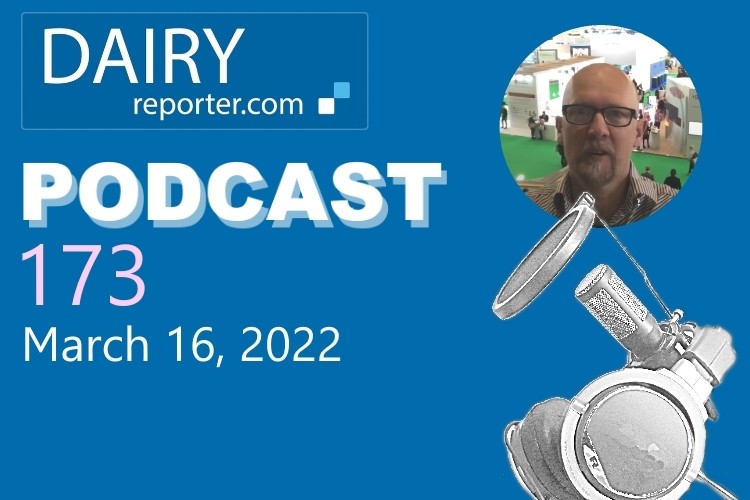Dairy Dialog podcast 173: Fortress Technology, STOP Foodborne Illness, Wipak

We also have our weekly look at the global dairy markets with Charlie Hyland at StoneX.
Fortress dual lane combi doubles down on dairy inspection waste
Fortress Technology has custom-engineered a twin aperture metal detector and dual lane Raptor checkweigher for one of the world’s premium dairy companies, helping to halve waste.
Receiving shredded cheese pouches directly from a dual head bagger, the design unlocks space and cost savings for the dairy plant.
Offering a customized solution, the twin lane conveyor configuration consolidates a single Fortress metal detector divided into two apertures and two independent weight verification Raptor checkweighers for optimized quality control. Each technology and lane has its own air blast reject mechanism to isolate metal contaminants and weight rejects, helping reduce and minimize good product being wasted by more than 50%. Measuring 10ft in length, Fortress also integrated a radius conveyor into the metal detector infeed.

European commercial manager Jodie Curry said, “The high-spec Fortress multi-aperture system was engineered specifically to ensure that that there was no trade-off in terms of performance and metal detection sensitivity. One of the key benefits of a twin aperture system is the halving of waste caused by rejects.”
The special dual-lane version of Fortress Technology’s multi-aperture metal detector comprises a single unit split into two smaller dedicated apertures for each lane that act as independent metal detectors. For optimal metal detection sensitivity the two apertures - measuring 102mm in height by 254mm wide - means packs pass individually through the center point of the metal detector.
“With output per hour being such a critical productivity benchmark, this game-changing multi-aperture design facilitates high speed and accurate metal detection and marks a step change for lean manufacturers seeking to reduce factory footprint and improve Total Cost of Ownership (TCO),” Curry said.
Fully integrated with the dairy plant’s upstream and downstream equipment and matching the 120-140 ppm output speed of the dual head VFFS bagging system, the compact geometry of the customized radius conveyor facilitates the positioning and orientation of product packs as they round the corner toward the metal detector. Providing optimal spacing between product packs as they are presented to each metal detector aperture helps to avoid congestion, bottlenecks and flexible packaging formats overlapping, which could lead to sensitive weight verification checks being distorted.
As each lane is programmed to run independently, the design helps minimize interruption to the packing process during product switchovers or if one lane stops working or requires maintenance. Additionally, the design gives the plant extra inspection and weight verification capacity, as two different product lines, pack sizes or SKUs can be run simultaneously adjacent to each other.
Air blast nozzles between the two outfeed conveyors independently remove contaminated product into lockable reject bins equipped with reject confirmation and bin full sensors. With heavier products, Fortress would typically suggest using a pusher, drop conveyor or retracting belt mechanism.
The hygienic dual-lane design also targets operational inefficiencies, notably upstream product giveaway, non-conforming food packs and packaging waste.
In milliseconds, two packs pass over two Raptor load cells to weigh, analyze, capture and report data simultaneously. For ease of integration, air blast nozzles reject out of weight specification products with minimal operative intervention.
To ensure traceability and compliance with retailer Codes of Practice and QA protocols, both the metal detector and Raptor checkweigher capture live OEE data. This enables the dairy to establish the operational parameters and extract statistics most valuable to their business, for instance volume, weight, inspection speed, rejects or downtime.
Equipped with Contact Reporter software, the dairy plant can export and convert time-stamped production data.
“This level of cohesive reporting on a multi-lane system provides valuable upstream trend feedback to boost operational efficiencies,” Curry said.
The modular 200mm wide conveyor assembly, conveyor decks and belts are all designed to be easily removed from the machine for rapid deep sanitation and maintenance.
Wipak UK launching recyclable paper butter wrap
Packaging supplier Wipak UK is set to launch a UK-first recyclable paper wrap for butter, which can be recycled at kerbside within the paper waste stream and boasts a 68% carbon footprint reduction when compared to market-standard wraps (aluminum/low-density polyethylene (LDPE)/paper laminate).
Made from renewable, FSC-certified paper, the decorative butter wrap is aluminum-free and covered in ultra-thin natural coatings, which the company said have excellent oxygen and water vapor barrier properties compared to standard paper, as well as superior grease resistance.
“Most butter wraps in the UK market are made of parchment paper or a grease-resistant paper which is commonly made into composite laminates with aluminum and polyethylene,” said Wipak UK’s technical development manager, Keith Gater.
“Although made from renewable resources, coated parchment papers do not promote a circular economy as they’re not easily recyclable.
“Unlike existing butter wraps on the market which are complex material structures, our consumer-friendly paper solution is fully recyclable within the kerbside paper and cardboard waste stream once it has been cleaned. What’s more, it maintains the look and feel of a traditional butter wrap, can be fully printed with brand imagery, and runs on existing butter wrap machinery.”
Having successfully passed shelf-life trials following packing on automated wrapping lines, Wipak UK’s recyclable butter wrap has also scored an A+ rating in recycling tests carried out by the BioComposites Centre at Bangor University.
“This classification is the highest possible score that can be achieved for paper recycling efficiency, whereby the pulp recovery must be a minimum of 98.5%,” Gater said.
“Our wrap is also compliant with UK-set guidelines for claiming paper recyclability, which require a minimum paper content of 85%.”
The butter wrap format is one of several new product development projects developed using Wipak UK’s combi laminator - part of a recent £5m+ machinery upgrade to enhance the packaging supplier’s sustainable product offering. The investment is helping Wipak UK move closer to its goal of reducing its company carbon footprint and achieving carbon neutrality by 2025.
“With growing pressure from consumers, brands and retailers need to take decisive action with disruptive sustainable packaging solutions that challenge traditional methods,” Gater said.
“Solutions like Wipak UK’s butter wrap will not only have significant environmental benefits, but will help to keep brands relevant in an increasingly competitive market."
STOP Foodborne Illness looks for action on Cronobacter
STOP Foodborne Illness, the voice for safe food, is calling on the FDA and CDC for Cronobacter sakazakii to be added to the Nationally Notifiable Disease List.
Currently, local and state health partners do not need to report incidences where someone has become ill from ingestion of C. sakazakii.
STOP Foodborne Illness said this means the FDA is unlikely to know of incidents that cause illnesses or death, and therefore can't demand a recall; epidemiologists are unable to identify illness clusters or better understand root causes of outbreaks; there can be a severe underreporting of illnesses; and potentially, more infants will get sick and some will die.
Following recent cases of C. sakazakii, STOP Foodborne Illness CEO Mitzi Baum, sent a letter to the director of the U.S. Centers for Disease Control and Prevention and the commissioner of the U.S. Food and Drug Administration to ask for C. sakazakii to be added to the Nationally Notifiable Disease List.
In the correspondence, Baum said while rare, C. sakazakii is extremely deadly to infants younger than three months of age, yet it is not included in CDC’s important pathogens that local and state health partners must report identifying.
“The lack of inclusion of this devastating pathogen on the Nationally Notifiable Disease List only adds to the potential of underreporting of illnesses, making it difficult for epidemiologists to do their important job of identifying clusters of illnesses to better understand sources and root causes of outbreaks. Lack of reporting also reduces the chances that FDA will become aware of incidents that need swift response and corrective action to protect infants,” Baum said.
“Federal agencies have focused their efforts on infant and maternal health for detection of Listeria monocytogenes; STOP appeals to both agencies to institute the same standards for Cronobacter sakazakii. There must be equivalent surveillance for both deadly bacteria.
“Now is the time to act. How can parents have trust in a system that does not protect the most vulnerable?”








